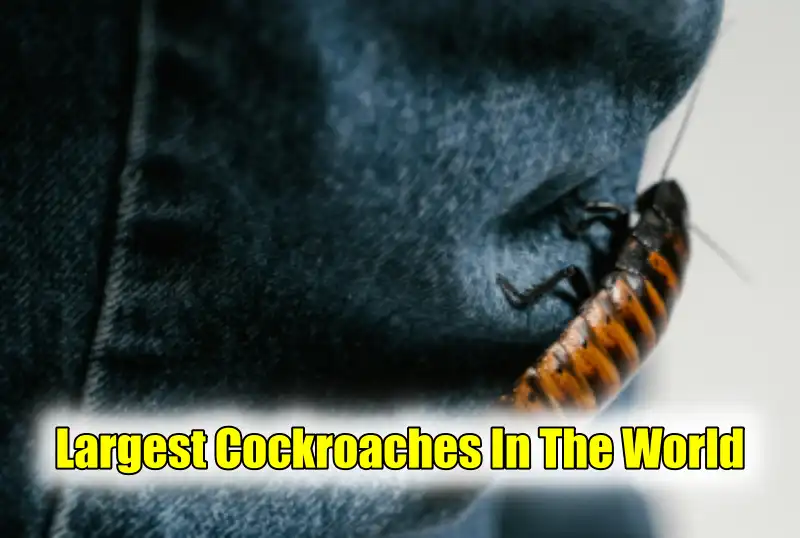The most general pest we are all afraid of is cockroaches. These insects inhabit diverse ecosystems worldwide, from caves to urban jungles. However, they are considered unhygienic, but they play crucial roles in these environments. But have you ever seen a cockroach that is 10 cm long? Here, we are going to look at some of the largest cockroaches in the world.
10 Largest Cockroaches In The World
10) Florida Woods Cockroach
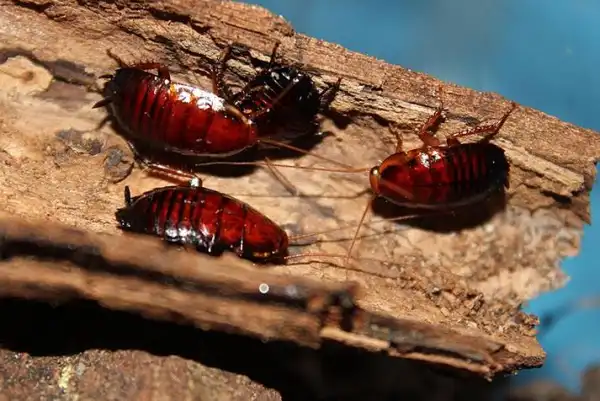
| Scientific name | Eurycotis floridana |
| Average size | 3-4 cm |
| Identification | dark to blackish brown body color |
| Geographical location | United States and Canada |
The Florida woods cockroach is the scientific name Eurycotis floridana. This world’s largest cockroach species can emit a foul-smelling directional spray when alarmed.
Its naming variations include Florida skunk roach, Florida stinkroach, skunk cockroach, stinking cockroach, and stinkroach.
The cockroach is dark to blackish brown or reddish brown after recent molting and has short tegmina and absent hind wings. Adults typically measure 30-40 mm.
9) Smokybrown cockroach
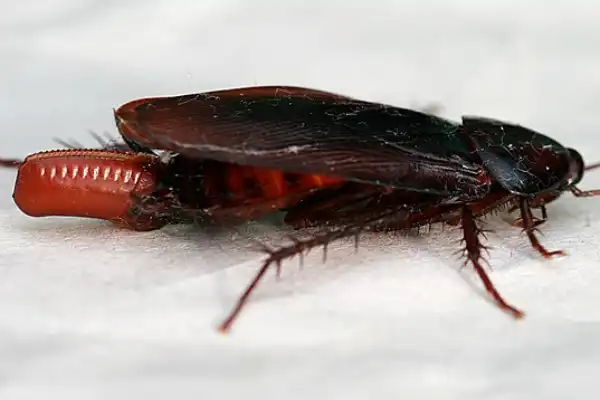
| Scientific name | Periplaneta fuliginosa |
| Average size | 3.2-3.5 cm |
| Identification | uniformly light to dark brown–mahogany body coloration |
| Geographical location | Japan, Southern United States |
The smokybrown cockroach is a large, winged species of cockroach, measuring 32-35 millimeters (1.3-1.4 in). Unlike the American cockroach, it has a uniformly light to dark brown-mahogany coloration and a dark, shiny thorax.
This detritivore feeds on various organic matter, including dry earthworms, pet food, pet waste, paper, and ripe fruits. It is closely related to the American cockroach but differs in its light-rimmed pattern on its thorax.
8) American cockroach
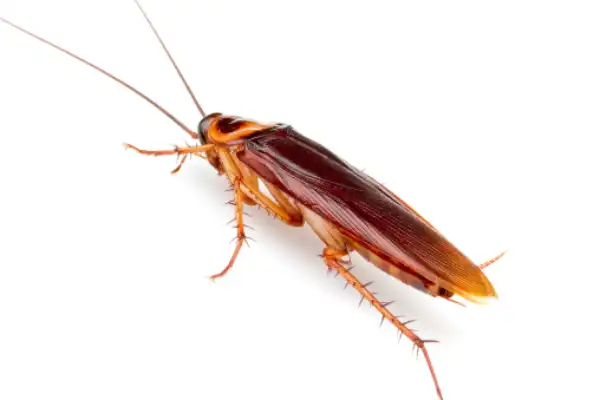
| Scientific name | Periplaneta americana |
| Average size | ~4 cm |
| Identification | Reddish brown body and a yellowish margin on the pronotum |
| Geographical location | United States and Africa |
The American cockroach is the largest common cockroach species and is often considered a pest. It is also known as the waterbug, ship cockroach, kakerlac, and Bombay canary.
The cockroach has a characteristic insect morphology with a head, trunk, and abdomen. It has two pairs of wings, fore wings (tegmina) and hind wings (metathorax).
The abdomen is divided into 10 segments surrounded by chitinous exoskeleton plates called sclerites. The cockroach has an average length of 4 cm and is about 7 mm tall. Immature cockroaches resemble adults but are wingless.
The cockroach is divided into three sections: the body, the pronotum, and the abdomen. The pronotum covers the dorsal surface of the thorax, while the abdomen is the most important part of the cockroach’s structure.
7) Warty Glowspot cockroach
| Scientific name | Lucihormetica verrucosa |
| Average size | ~4 cm |
| Identification | yellow spots on the pronotum covered by a translucent cuticle |
| Geographical location | Venezuela and Colombia |
Lucihormetica verrucosa, also known as the warty glowspot cockroach, is a giant cockroach native to Venezuela and Colombia. It is mainly black or dark brown, with a white margin to the dorsal sclerites. The species is sexually dimorphic, with males being slightly smaller than females.
The cockroaches have large, yellow spots on the pronotum covered by a translucent cuticle, which were traditionally thought to be luminescent organs.
However, when fed carrots, the spots deepened to orange or red. The researchers hypothesized that the pigmented spots may play a role in male aggression, mate choice, or provide warning signals.
6) Death’s head cockroach
| Scientific name | Blaberus craniifer |
| Average size | 3-5 cm |
| Identification | Simpler black patch and paler wings |
| Geographical location | Mexico, the West Indies, North and Central America |
The Death’s Head Cockroach is a large winged insect native to Mexico, the West Indies, and Central America, with a small black patch on its head resembling a “Death’s head.” Despite their black wings, they glide from higher places to lower ones.
Known as Blaberus craniifer, they are the largest cockroach species found in North America, and their scientific name, Craniifer, means “Carrier of the head.”
They can grow over two inches in length and are sometimes confused with the Discoid Cockroach, which has a simpler black patch and paler wings. They can live up to one year.
5) Trinidad bat-cave roach
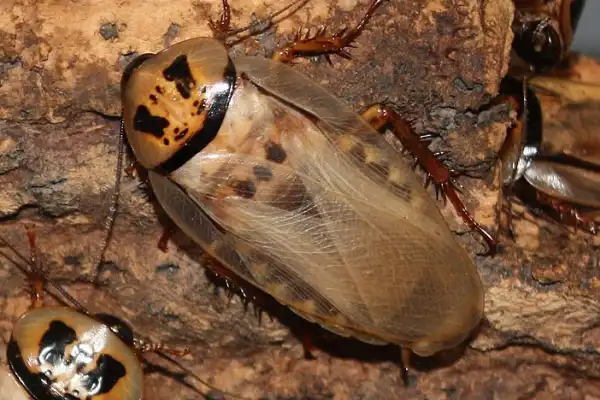
| Scientific name | Eublaberus distanti |
| Average size | ~6.4 cm |
| Identification | Six yellow spots along its sides |
| Geographical location | Central and South America |
Eublaberus distanti, also known as the six-spotted cockroach or Trinidad bat-cave roach, is a Central and South American cockroach primarily found in caves.
Its common name refers to its six yellow spots along its sides. Adults, both male and female, have wings but do not fly and grow to 6.4 cm in length. Males are generally smaller and have longer wings.
4) Hissing cockroach
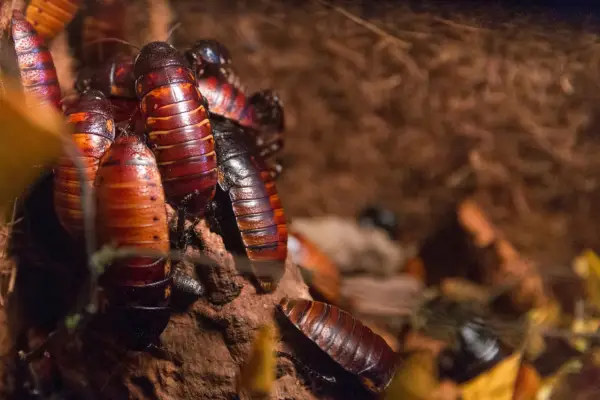
| Scientific name | Gromphadorhina portentosa |
| Average size | 5-7.5 cm |
| Identification | Black head and legs |
| Geographical location | Madagascar |
The Madagascar hissing cockroach, also known as the hissing cockroach or simply hisser, is a large species of cockroach native to Madagascar, a country off the African mainland.
They are wingless and use the “hissing” sound as their primary defense against predators. They can reproduce asexually or sexually and are excellent climbers. Males are distinguished by thicker antennae and pronounced bumps on the pronotum.
Females carry the ootheca internally and release the young nymphs only after their offspring have emerged.
In captivity, these insects can live up to 5 years and feed primarily on vegetable material. They can be distinguished by their thicker antennae and pronounced bumps on the pronotum.
3) Giant Burrowing Cockroach
| Scientific name | Macropanesthia rhinoceros |
| Average size | 6-8cm |
| Identification | wingless cockroaches |
| Geographical location | Australia |
The giant burrowing cockroach, also known as the rhinoceros cockroach or Queensland giant cockroach, is the heaviest species of cockroach native to Australia, found in tropical and subtropical parts of Queensland.
It is part of the Blaberidae family and is nocturnal. The cockroach is characterized by its large size and weight, with an adult reaching over 60 mm and 75-80 mm.
Its pronotum serves as a shovel for digging, and its spiny tibiae aid in burrowing. Adult males have a more pronounced scoop and have lifespans of up to ten years in captivity.
Nymphs, the immature stages of the cockroach, are creamy white when born but develop a reddish brown color.
2) Megaloblatta longipennis
| Scientific name | Megaloblatta longipennis |
| Average size | 4.5-9.7 cm |
| Identification | Blackish brown body |
| Geographical location | Colombia, Ecuador, and Peru |
Megaloblatta longipennis is a large cockroach species in the Ectobiidae family, native to Colombia, Ecuador, and Peru. It measures over three and a half inches in length and over an inch and a half in width. The largest specimen measured 9.7 cm in length, 4.5 cm in width, and had a wingspan of 20 cm.
The related M. blaberoides can reach about the same length and wingspan. The species’ range sometimes extends into Panama, based on misidentifications of the closely related M. blaberoides.
1) Central American Giant Cave Cockroach
| Scientific name | Blaberus giganteus |
| Average size | 7.5-10 cm |
| Identification | Brown body with black markings |
| Geographical location | Mexico, Guatemala, Panama, Colombia, Ecuador, Venezuela, Costa Rica, Brazil, Trinidad and Tobago, Cuba, Hispaniola, Guyana, Suriname, and French Guiana |
Blaberus giganteus, also known as the Central American giant cave cockroach or Brazilian cockroach, is a large cockroach native to the Neotropical region. It is one of the world’s largest, with males reaching up to 7.5 cm and females 10 cm.
The cockroaches are lightly built with flattened bodies, brown with black markings, and have a wingspan of around 15 cm. Both males and females have paired appendages, with males having styli. Adults have two pairs of wings folding back over the abdomen.
Conclusion:
These are some of the largest cockroaches in the world. Each species has evolved unique survival strategies, such as glide ability or distinctive hissing sound.
Cockroaches thrive in various environments, from cave depths to urban streets, and play significant roles in nutrient cycling, decomposition, and pollination, highlighting the interconnectedness of life on Earth. If you want to know more about such animals and insects, keep looking for them on HowItSee.
Reference:
- Wikipedia
- Atozanimalia
Also Read:

As a content writer, I like to write about different niches. I have a curiosity about nature and animals. And like to learn about them. Through my writing, I like to share my experience and knowledge with you. I hope you are enjoying it too.
